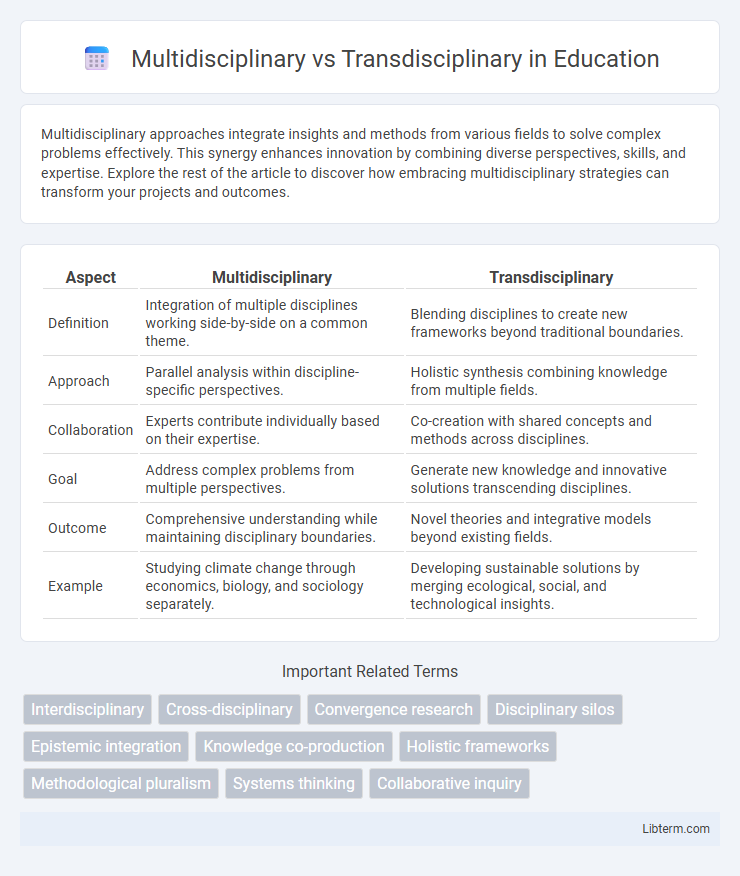Multidisciplinary approaches integrate insights and methods from various fields to solve complex problems effectively. This synergy enhances innovation by combining diverse perspectives, skills, and expertise. Explore the rest of the article to discover how embracing multidisciplinary strategies can transform your projects and outcomes.
Table of Comparison
| Aspect | Multidisciplinary | Transdisciplinary |
|---|---|---|
| Definition | Integration of multiple disciplines working side-by-side on a common theme. | Blending disciplines to create new frameworks beyond traditional boundaries. |
| Approach | Parallel analysis within discipline-specific perspectives. | Holistic synthesis combining knowledge from multiple fields. |
| Collaboration | Experts contribute individually based on their expertise. | Co-creation with shared concepts and methods across disciplines. |
| Goal | Address complex problems from multiple perspectives. | Generate new knowledge and innovative solutions transcending disciplines. |
| Outcome | Comprehensive understanding while maintaining disciplinary boundaries. | Novel theories and integrative models beyond existing fields. |
| Example | Studying climate change through economics, biology, and sociology separately. | Developing sustainable solutions by merging ecological, social, and technological insights. |
Introduction to Multidisciplinary and Transdisciplinary Approaches
Multidisciplinary approaches integrate knowledge from various disciplines, engaging experts to address complex problems while maintaining discipline-specific perspectives. Transdisciplinary approaches transcend traditional boundaries, creating holistic frameworks that synthesize insights across fields and involve stakeholders beyond academia. Both approaches enhance innovation and problem-solving but differ in depth of integration and collaboration scope.
Defining Multidisciplinary Collaboration
Multidisciplinary collaboration involves experts from diverse disciplines working side by side, each contributing specialized knowledge to address a common problem without integrating their approaches. It emphasizes parallel contributions where individual disciplinary perspectives remain distinct and operate independently. This approach facilitates comprehensive problem-solving by combining varied expertise while maintaining clear boundaries between disciplines.
Understanding Transdisciplinary Integration
Transdisciplinary integration transcends traditional disciplinary boundaries by fostering collaborative knowledge co-creation among diverse fields and stakeholders, aiming for holistic solutions to complex real-world problems. Unlike multidisciplinary approaches that simply juxtapose disciplinary perspectives, transdisciplinary research synthesizes methods, theories, and frameworks into unified systems of understanding. This integrative process enhances innovation and applicability, driving systemic change in fields such as sustainability science, healthcare, and urban planning.
Key Differences Between Multidisciplinary and Transdisciplinary
Multidisciplinary approaches involve experts from different disciplines working in parallel, maintaining distinct perspectives and methods within a shared framework. Transdisciplinary approaches transcend traditional disciplines by integrating and synthesizing knowledge to create new frameworks and holistic solutions. The key difference lies in multidisciplinarity's additive collaboration versus transdisciplinarity's transformative integration.
Benefits of Multidisciplinary Teams
Multidisciplinary teams combine experts from diverse fields, enabling comprehensive problem-solving through specialized knowledge integration. These teams enhance innovation by leveraging distinct perspectives, improving decision-making and productivity across complex projects. Effective communication within multidisciplinary groups fosters collaborative environments that accelerate progress and optimize resource utilization.
Advantages of Transdisciplinary Methods
Transdisciplinary methods integrate knowledge from multiple disciplines to create holistic solutions that traditional multidisciplinary approaches may overlook. These methods foster innovation by transcending disciplinary boundaries, enabling collaborative problem-solving that addresses complex real-world challenges. Enhanced flexibility and the inclusion of stakeholder perspectives further distinguish transdisciplinary approaches, promoting more sustainable and impactful outcomes.
Challenges in Multidisciplinary Projects
Multidisciplinary projects often face challenges related to fragmented communication and differing disciplinary languages, which can hinder effective collaboration and knowledge integration. Conflicting methodologies and goals among team members from diverse fields create obstacles in aligning project objectives and outcomes. This contrasts with transdisciplinary approaches that emphasize integrating perspectives to generate unified frameworks and shared problem-solving strategies.
Barriers to Effective Transdisciplinary Work
Multidisciplinary work involves collaboration across disciplines with each maintaining its own perspective, while transdisciplinary work seeks to integrate and transcend individual disciplines to create new frameworks and solutions. Barriers to effective transdisciplinary work include disciplinary jargon that hinders communication, institutional structures favoring siloed research, and challenges in aligning diverse epistemologies and methodologies. Overcoming these obstacles requires fostering mutual understanding, flexible organizational policies, and shared goals that promote true integration across fields.
Real-World Examples in Research and Practice
Multidisciplinary research involves experts from different disciplines working in parallel on a common problem, such as climate change studies where ecologists, economists, and sociologists contribute separately to a broader understanding. Transdisciplinary approaches integrate and transcend individual disciplines to create new frameworks, exemplified by urban sustainability projects where scientists, policymakers, and community members co-develop innovative solutions that merge scientific knowledge with local practices. These real-world examples highlight how multidisciplinary efforts provide diverse perspectives, while transdisciplinary collaboration fosters holistic, actionable knowledge beyond traditional academic boundaries.
Choosing the Right Approach for Your Project
Multidisciplinary projects integrate expertise from multiple disciplines, maintaining distinct boundaries between fields to address complex problems through parallel insights. Transdisciplinary approaches transcend traditional disciplinary boundaries, fostering collaborative innovation and holistic solutions by co-creating knowledge with stakeholders beyond academia. Selecting the right approach depends on project goals, complexity, and the desired level of integration and stakeholder involvement for effective problem-solving.
Multidisciplinary Infographic

 libterm.com
libterm.com